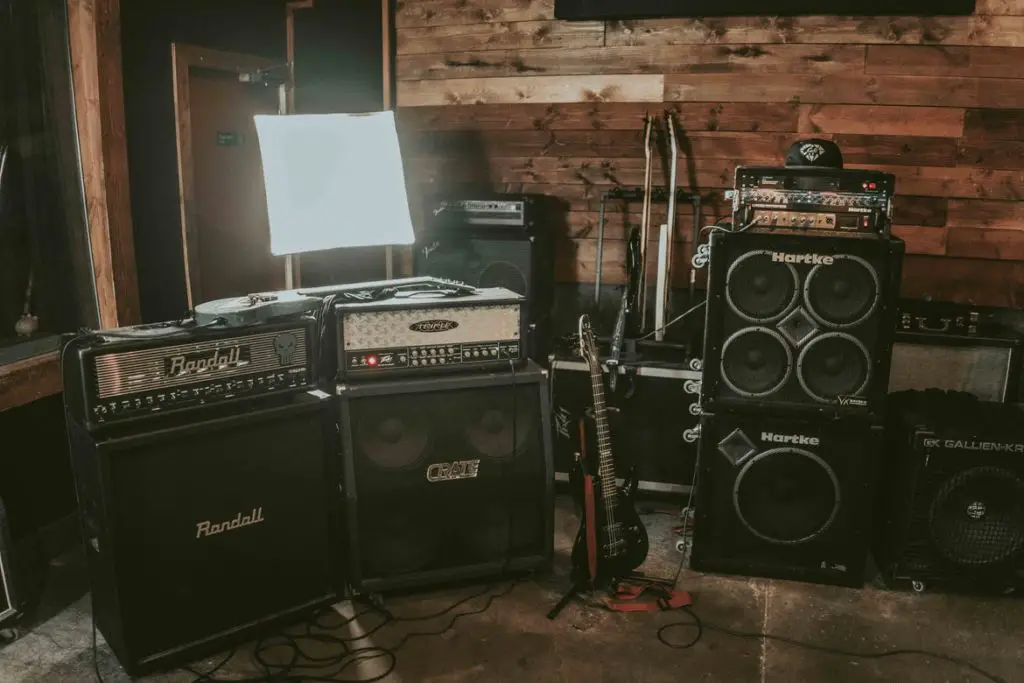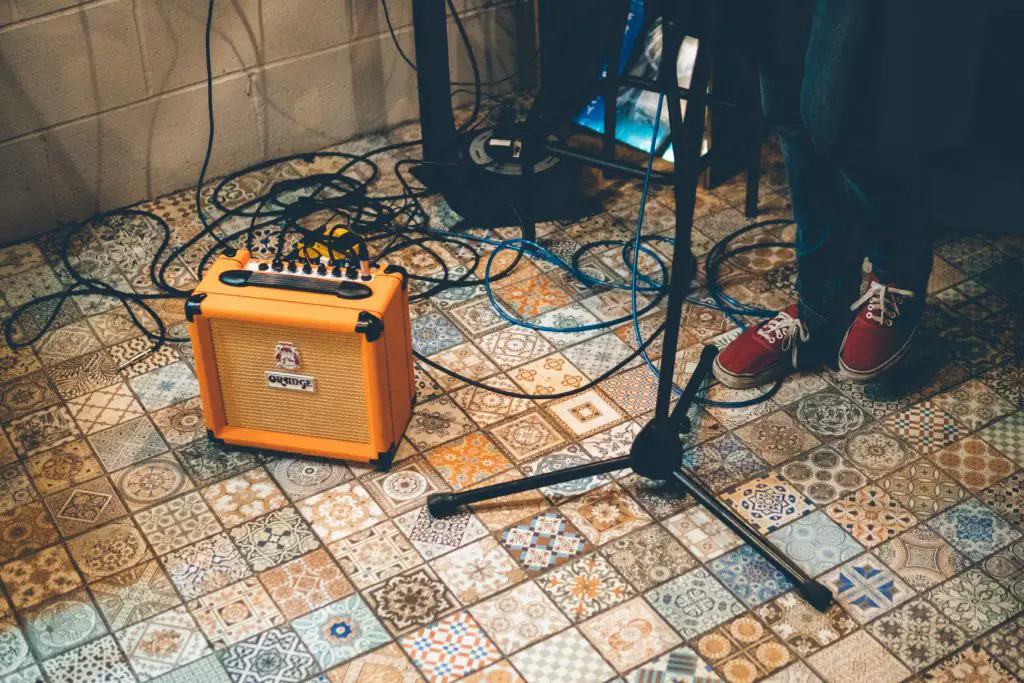So you’ve decided to switch from the tinny tone of your tiny practice amp to a real force with more power, better sound, and increased volume.
Congrats! You’ve taken your first step to become an absolute shredder. That is, of course, if you know the difference between all the different types of guitar amps.
The market is flooded with many varieties of guitar amplifiers. They may be categorized in many ways, but the essential criteria remain the technology employed to intensify guitar signals.
Before you run out and buy the first model that captures your eye, there are some things to consider. It’s important to know what kind of music you’re interested in playing.
Are you solely into metal, or do you also want to play jazz? Do you need an amp that can handle many different styles, or would one specializing in just one genre be all you need? Whatever your preferences may be, there’s an amplifier out there that can meet them.
Quick Links
The Four Main Types of Guitar Amplifiers
To narrow down your selection, you should look at the amps themselves. Here’s a rundown of the four primary types of guitar amps in the market today.
1. Tube Amps
Tube amplifiers are also referred to as “valve” amps, use vacuum tubes to recreate sounds. They provide a more distinctive and warm tone than solid-state amplifiers, which adds to your performance’s overall depth and character.
However, this warmth can also prove problematic when maintaining clean tones that stay clear no matter how high you turn up the volume. This is why most tube amps are paired with an equalizer or some form of tone dialing device such as guitar pedals.
They are generally more expensive than their transistor counterparts because they are made with meticulously handcrafted components. Many musicians favor them for this reason and their ability to generate specific sound and tonal characteristics.
2. Solid-State Amps
These amplifiers use transistors and integrated circuits to amplify an instrument’s signal. Solid-state amps have become standard equipment for both live and recording applications because they are more powerful.
This type of amplifier can achieve louder volumes without additional issues such as unwanted distortion. Some models feature one channel, which means only one input source can be used at a time. At the same time, others offer multiple channels, so several instruments or microphones can be plugged into the amp.
Solid-state amps are usually quite affordable, but certain features like digital effects, auxiliary inputs, and tone controls require more expensive models. It provides excellent performance but doesn’t have the same level of warmth or clarity as tube-type designs.
This is because transistor circuitry doesn’t offer as much dynamic responsiveness as its tube counterparts. Also, solid-state units generally can’t produce sounds with lots of effects like a verb, delay, and chorus.
3. Modeling Amps
If you are not a big fan of dialing in your tone, have three minutes to spare, and are willing to spend the cash on it, then modeling amps may be the best option for you.
Modeling amps provide an easy way to dial in your favorite amplifier’s sound without having to purchase the actual amp itself. Using computer software that models your favorite amp can give you all the benefits of owning one without wasting money buying one—sounds good, right?
Since they are digital by nature, there is no arguing about how warm or clear something sounds because everything is based on numbers rather than subjective opinions.
However, the only downside of these types of amplifiers is typically costly due to their high-tech nature. But those who are passionate about their music should not worry as there is a cheaper alternative.
4. Hybrid Amps
The hybrid amp works by combining digital circuitry with analog circuitry to give you the best from both worlds – excellent tone along with effects flexibility.
The combination is quite clever since it gives users an affordable choice without compromising power or performance.
Generally speaking, this setup gives you a warm tone with more dynamics compared to pure tube amps. But it also allows for effects and custom tones that traditional tube amps cannot do.
Hybrid amps also come in an excellent design and are inexpensive, making them the best of both worlds. With this type of amp, you get everything needed, so it will be hard to decide which one to go for.

Why Should You Use Guitar Amplifiers?
In the world of instrument amplification, amps are king. Most people associate musical instruments with a unique tone and sound – a tone that can be achieved only through an amplifier.
Many guitarists have their own signature sound, which is often associated with the amp they use or built around it.
Guitar amplifiers are electrical devices that translate string vibrations from guitars and other instruments into sound. They can also be used to amplify string vibrations from bowed instruments such as violins and cellos, called electric basses.
Guitar amps come in different types, designs, and shapes – each has its own unique features and characteristics that produce a variety of sounds for the instrument.
The following are the benefits you can get when using guitar amplifiers.
- You can replicate or imitate the sound of a specific musical instrument.
- Amplifiers make your guitar sound better and increase its volume.
- You can play with other instruments using it as a speaker for electric keyboards and bass guitars.
- It is perfect for recording in studios. Most amps come with their own built-in effects and overdrive features that enhance certain styles of music, such as jazz, blues, or metal.
- You can also use an effect pedal to achieve this feature when playing live gigs if the amp doesn’t have them already.
Important Tips When Using Guitar Amps
Amplifiers come in all shapes and sizes. Also, the wattage of an amp is one of its main features.
The more watts your amp has, the louder it will get, and this will allow you to be heard even if you play in a loud environment or with other instruments on stage.
Also, the higher the wattage of your amplifier, the lower you can go with playing notes and chords.
You can start by practicing on a 30-50 watt amp and then move up to something more significant if you’re ready for it. Some amps are tube-powered, while others are solid-state.
Tube amplifiers often provide a warmer timbre but generate more heat that could potentially damage your amp’s components or even fry them all together. Solid-state amps, on the other hand, are lighter in weight and also come with some built-in effects like tremolo, reverb, etc.
If you want an amp that sounds warm but provides enough clarity as well, opting for something in between is usually ideal.

Some Final Words
Guitar amplifiers are a vital piece of equipment if you want to optimize your playing experience.
However, it should be noted that various types of amps have been developed for different purposes. So knowing their history and key features can help you determine what amp is best suited for you or will give you the sound you’re looking for.
In addition, a basic understanding of the physics behind how an amp works comes in handy when learning how to build one from scratch.
After all, even if you get an amp with every feature under the sun, if your tone and channel controls don’t give you enough variety, you’ll never be satisfied with it. So, make this article your guide in choosing the right amp for yourself.







